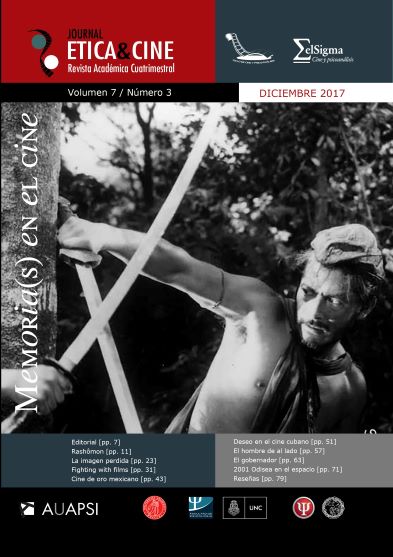Evocation of memories through Mexican gold cinema
DOI:
https://doi.org/10.31056/2250.5415.v7.n3.19623Keywords:
Dementia, Mexican cinema, Reminiscence therapy, Mexican elderly, MemoryAbstract
Reminiscence therapy, which consists of memory recall in people with dementia through support materials, is a resource rarely used in Latin American countries, due to the lack of appropriate materials and the lack of a guide or method. The use of cinema as a tool of reminiscence therapy has been a recent incursion, its application has been carried out in the United Kingdom as well as in the United States of North America. Under the assumption: Cinema can detonate memories in elderly people with dementia, besides functioning as an integrator of various elements of the symbolic material culture referring to the time corresponding to the so-called reminiscence bump, three interventions were performed in a group of 15 elderly people with dementia, located in the city of Toluca, Mexico. The film of the Mexican cinema of the golden era was projected: “I am rooster where I want (Jimmy)” (1954). Its projection was divided in three sessions, in which material of support was used, extracted of the film, this material was classified according to the human senses in order to promote the sensorial stimulation in the participants. Older people with dementia are interested in talking about movies and movies. There were autobiographical memories of the participants, as well as positive changes in mood and behavior.References
Aguirre, J. M. B. (2015). Hay insuficientes geriatras en México, advierte INAPAM. El Universal.Obtenido del sitio:http://archivo.eluniversal.com.mx/n.
Baudrillard, J. (2010). El sistema de los objetos. Ciudad de México, México: Siglo XXI.
BBC. (2012). Recuperar los recuerdos con películas antiguas. Obtenido del sitio:http://www.bbc.com/mundo/noticias 2012/05/120518_demencia_peliculas_antiguas_m en.shtml
Beard, J., Officer, A., Cassels, A., Bustreo, F., Worning, A. M., y Asamoa-Baah, A. (2015). Informe mundial sobre el envejecimiento y la salud. E.U.A.: OMS
Berntsen, D., y Bohn, A. (2009). Cultural life scripts and individual life stories. En P. Boyer y J. Wertsch (Eds.), Memory in mind and culture: Cambridge.
Buse, C., y Twigg, J. (2014). Women with dementia and their handbags:Negotiating identity, privacy and ’home’ through material culture. Journal of Aging Studies, 30, 14-22.
Buse, C., y Twigg, J. (2015). Materialising memories: Exploring the stories of people with dementia through dress. Ageing and Society. doi:10.1017/S0144686X15000185
Castro-Ricalde, M. (2014). El cine mexicano de la edad de oro y su impacto internacional. La Colmena, 82, 9-16.
Castro-Ricalde, M., y Irwin, R. M. (2011). El cine mexicano "se impone" mercados internacionales y penetración cultural en la época dorada. México DF: UNAM.
Cotelli, M., Manenti, R., y Orazio, Z. (2012). Reminiscence therapy in dementia: A review. Maturitas, 72(2012), 203-205. doi:http://dx.doi.org/10.1016/j.maturit.
Dementia Village Architects.(2015). Villas para la demencia. Obtenido de: http://dementiavillage.com
Dulcey-Ruiz, E. (2015). Envejecimiento y vejez. Categorías y conceptos R. L. d. G.-S. d. H. Editores (Ed.) .
García-Riera, E. (1974). El cine y su público. México DF: Fondo de Cultura Económica.
Geertz, C. (2006). La interpretación de las culturas (Undécima ed.). México: Gedisa.
Iacub, R. (2011). Identidad y envejecimiento. Buenos Aires: Paidós.
Im still here foundation. (2016). Meet me at the movies…and make memories. Obtenido de: http://www.imstillhere.org/takes-a-.
INEGI. (2010). Censo de población y vivienda. México. Obtenido de: http://www.beta.inegi.org.mx/proyec.
Kalu, M. (2015). Literature review on the effectiveness of using reminiscence therapy in treating dementia.O btenido de: https://www.researchgate.net/public. doi:10.13140/RG.2.1.4105.8720
Latha, K. S., Bhandary, P. V., Tejaswini, S., y Sahana, M. (2014). Reminiscence therapy: An overview. Middle East Journal of Age and Ageing, 11(1).
Malafouris, L., y Renfrew, C. (2013). How Things Shape the Mind: A Theory of Material Engagement. MIT Press.
Martínez-Rodríguez, T. (2011). La atención gerontológica centrada en la persona: Guía para la intervención profesional en los centros y servicios de atención a personas mayores en situación de fragilidad o dependencia. E. J. A. Z. Nagusia (Ed.)
Memory-bank. (2012). Memory bank. Obtenido de: https://www.rcpsych.ac.uk/pdf/Memor.
Monsalve-Robayo, A. M., y Rozo-Reyes, C. M. (2009). Integración sensorial y demencia tipo alzheimer principios y métodos para la rehabilitación. Rev. Colombiana de Psiaquiatría, 38(4). OMS (2015). Demencia. En OMS (Ed.), Nota descriptiva No. 362
Prince, M., Wimo, A., Guerchet, M. A., Gemma-Claire., Wu., Y.-T., y Prina, M. (2015). The global impact of dementia. Obtenido de: http://www.alz.co.uk/research/World.
Ricarte-Trives, J. J., Latorre-Postigo, J. M., y Ros-Segura, L. (2013). Diseño y análisis del funcionamiento del test de memoria autobiográfica en población española. Apuntes de Psicología, 31(1), 3-10.
Sosa, A. L. (2016). XXI Congreso Nacional de Alzheimer. León Guanajuato México.
Tulving, E. (1972). Episodic and semantic memory. En E. Tulving y W. Donaldson (Eds.), Organization of memory. New York: Academic Press.
Williams, H. L., y Conway, M. (2009). Networks of autobiographical memories. En P. Boyer y J. Wertsch (Eds.), Memory in mind and culture: Cambridge.
Downloads
Published
Issue
Section
License
Los autores que publiquen en Ética y Cine Journal aceptan las siguientes condiciones:
Los autores/as conservan los derechos de autor © y permiten la publicación a Ética y Cine Journal, bajo licencia CC BY-SA / Reconocimiento - Reconocimiento-CompartirIgual 4.0 Internacional. La adopción de esta licencia permite copiar, redistribuir, comunicar públicamente la obra, reconociendo los créditos de la misma, y construir sobre el material publicado, debiendo otorgar el crédito apropiado a través de un enlace a la licencia e indicando si se realizaron cambios.

Este obra está bajo una licencia de Creative Commons Reconocimiento-CompartirIgual 4.0 Internacional.




